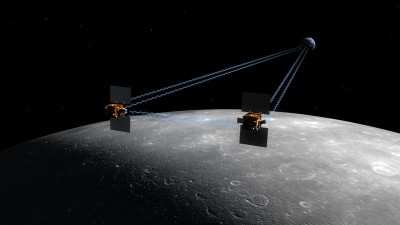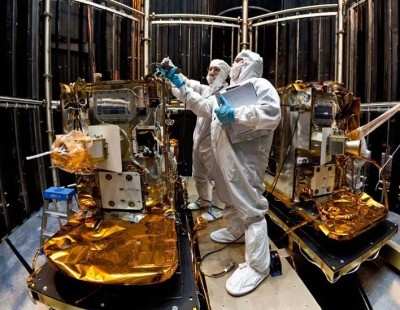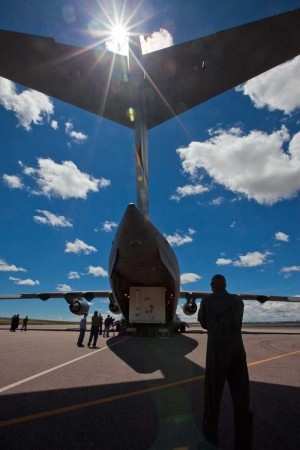Wed, May 25, 2011
Lunar Orbiters Set For September Launch
NASA's twin GRAIL spacecraft were delivered to Kennedy Space
Center in Florida on May 20. The two Lockheed Martin vehicles will
undergo four months of final testing and processing in preparation
for launch from Cape Canaveral Air Force Station on a United Launch
Alliance Delta II Heavy launch vehicle in early September.

NASA Artist's Rendering GRAIL Satellites On
Orbit
The lunar orbiters will fly 30 miles above the surface of the
moon in precision formation to determine the structure of the lunar
interior from crust to core and to advance understanding of the
thermal evolution of the moon.
"It has taken a great deal of dedication and hard work from the
entire team to bring us to this moment," said John Henk, GRAIL
program manager at Lockheed Martin Space Systems Company. "Building
two spacecraft simultaneously brought some challenges, but I'm
proud that we are delivering them to the launch site on schedule
and under budget."

Satellites Prepped For Transport
"It has taken a great deal of dedication and hard work from the
entire team to build two spacecraft simultaneously and achieve this
delivery milestone on schedule and under budget," said John Henk,
GRAIL program manager at Lockheed Martin Space Systems Company. "We
look forward to preparing for launch and achieving total mission
success on this important program."
Both of the 440-pound spacecraft were transported on an Air
Force C-17 transport plane in an environmentally controlled
container. The plane departed from Buckley Air Force Base near
Denver and touched down at 1940 EDT at Kennedy Space Center's
Shuttle Landing Facility. The spacecraft were then transported to
Astrotech Space Operations in Titusville, FL, for final launch
processing.

The Gravity Recovery And Interior Laboratory (GRAIL) mission
will fly nearly-identical spacecraft in tandem orbits around the
moon for several months to measure its gravity field in
unprecedented detail. The mission will also answer longstanding
questions about Earth's moon, and provide scientists a better
understanding of how Earth and other rocky planets in the solar
system formed.
More News
He Attempted To Restart The Engine Three Times. On The Third Restart Attempt, He Noticed That Flames Were Coming Out From The Right Wing Near The Fuel Cap Analysis: The pilot repor>[...]
Make Sure You NEVER Miss A New Story From Aero-News Network Do you ever feel like you never see posts from a certain person or page on Facebook or Instagram? Here’s how you c>[...]
From 2009 (YouTube Edition): Leading Air Show Performers Give Their Best Advice for Newcomers On December 6th through December 9th, the Paris Las Vegas Hotel hosted over 1,500 air >[...]
Aero Linx: NASA ASRS ASRS captures confidential reports, analyzes the resulting aviation safety data, and disseminates vital information to the aviation community. The ASRS is an i>[...]
“For our inaugural Pylon Racing Seminar in Roswell, we were thrilled to certify 60 pilots across our six closed-course pylon race classes. Not only did this year’s PRS >[...]
 NTSB Final Report: Rutan Long-EZ
NTSB Final Report: Rutan Long-EZ ANN FAQ: Turn On Post Notifications
ANN FAQ: Turn On Post Notifications Classic Aero-TV: ICAS Perspectives - Advice for New Air Show Performers
Classic Aero-TV: ICAS Perspectives - Advice for New Air Show Performers ANN's Daily Aero-Linx (06.28.25)
ANN's Daily Aero-Linx (06.28.25) Aero-News: Quote of the Day (06.28.25)
Aero-News: Quote of the Day (06.28.25)





